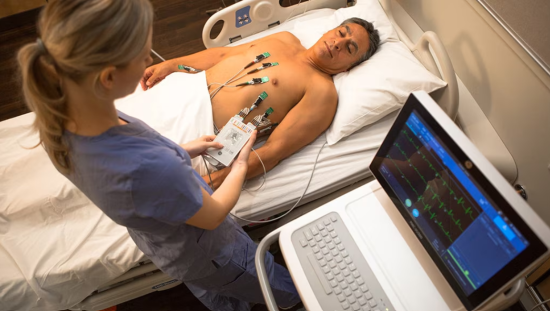The pharmacology of reversal agents: their benefits and side-effects
In this podcast, Dr. J. Ross looks into the pharmacology of reversal agents and benefits and side effects
Show Notes
Transcript
Speakers
Welcome to this podcast series produced by the Association of Anesthetists and sponsored by GE HealthCare. On the subject of neuromuscular monitoring in 2024, are we practicing to the highest possible standards?
In this podcast, Dr. J. Ross looks into the pharmacology of reversal agents and benefits and side effects
Insights, interviews and best practices by clinicians for clinicians. Welcome to GE HealthCare's Clinical View podcast.
Andrew Mortimore: Welcome everybody to this podcast produced by the Association of Anesthetists and sponsored by GE HealthCare. On the subject of neuromuscular monitoring in 2024, are we practicing to the highest possible standards? The podcast will cover four main areas.
Firstly, the pharmacology of reversal agents and benefits and side effects. Then an overview of strategies for reversing neuromuscular block. Followed by an update on the latest American and European guidelines on monitoring neuromuscular block.
And then finally, techniques of quantitative neuromuscular monitoring, which is the best equipment to use. We hope you will enjoy this podcast and gain something from it. So thank you very much.
We're now joined by Dr. J. Ross Renew, who completed his medical school at the University of South Carolina School of Medicine. Dr. Renew completed anesthesia residency at Mayo Clinic, Florida, and his fellowship in adult cardiothoracic anesthesiology at Mayo Clinic in Rochester. Dr. Renew is currently an associate professor of anesthesiology and serves as the vice chair of research. His research interests involve neuromuscular blockade and monitoring, transesophageal echocardiography, and caring for the cardiac patient undergoing non-cardiac surgery. So thanks very much, Ross, for joining us.
And you've agreed to talk to us about the overview of strategies for reversing neuromuscular block. So thank you very much for that and welcome. On behalf of GE HealthCare, our sponsors, and the Association of Anesthetists.
So I'm just going to ask you the first question. What are the main considerations when choosing a strategy to reverse neuromuscular block, and how does the choice of muscle relaxant influence this decision?
Dr. J. Ross Renew: Thanks, Andrew, and thanks for having me. I think there's kind of two guiding principles when we start to think about reversal strategies and trying to really deliver the best care for our patients at a critical point in the operation. One of which is to, you know, these medications, these reversal agents have side effects, and so we've got to consider the side effect profile and obviously individualize based on patient factors.
And so kind of a one-size-fits-all approach is certainly not the way to go, and we really should be individualizing our care. But I think one of the bigger drivers is this idea that, you know, why are we giving reversal agents at all? And that's to avoid residual weakness.
And, you know, there's mountains of evidence demonstrating complications that are associated with residual weakness, and we really can't just rely on, you know, clinical assessment or even a peripheral nerve stimulator to say, wow, those look like four strong twitches, I think my patient's okay. All that to say, we need to be incorporating both monitoring and reversal agents to deliver optimal neuromuscular blockade management. Certainly the monitor allows us to determine the dose, which is an important strategy.
It lets us check the level of blockade, and our reversal agents are kind of triaged based on the depth of blockade at the time of reversal administration. And so they also allow us to have evidence that our patients have adequately recovered and ultimately not have residual weakness, and thus keeping them safe from the complications associated with it. You know, the part to considering what reversal agents would be best for our patients is certainly the type of neuromuscular blocking agents used.
As you'll remember, the Benzylisoquinoline agents, Atracurium, Cisatracurium can be reversed with neostigmine, whereas neostigmine is also able to reverse the aminosteroidals, in contrast with Sugammadex, which can only reverse the aminosteroidals, rocuronium, vecuronium, etc. And I'll show you a couple examples from our practice. When we had Sugammadex introduced to our practice, it had kind of a downstream effect on the kind of neuromuscular blocking agents that were chosen.
You know, Sugammadex has a high affinity for particularly rocuronium, and so it's interesting to see is once our group got a hold of Sugammadex, our Sugammadex use went up, but also our rocuronium use went up. And really the times that we use the Benzylisoquinoline now would be things like if they had allergies to aminosteroidals, or if there was some contraindication, maybe severe renal impairment. And so this gets back to factoring in patient considerations.
All these things kind of tie in and trying to help you develop an individualized, safe reversal plan for your patient.
Andrew Mortimore: Thank you very much for that. So secondly then, in what situations would a clinician opt for a pharmacological reversal versus allowing spontaneous recovery, and what are the pros and cons of each approach?
Dr. J. Ross Renew: Great, good question. So I mentioned earlier in my prior response that one of the factors, strategies that goes into picking a reversal agent is to consider and trying to minimize the potential side effects that could come with them. Certainly when we give neostigmine, we have to co-administer an anti-muscarinic to avoid some of the side effects associated with neostigmine administration.
And so is there a path where we can avoid reversal altogether and avoid some of these potential side effects? Certainly it's unlikely to have major side effects from these drugs, but when we start expanding out into large populations, the chances of this happening are not zero. And so eventually some subset of patients will have complications related to the reversal agents in and of itself.
And so spontaneous recovery is something that can be accomplished, and certainly there is a role for it in modern anesthesia practices. But I like to emphasize that the pathway to safely omitting reversal is through monitoring. I would feel very comfortable omitting reversal and avoiding the potential side effects if I had a quantitative monitor on that demonstrated adequate recovery.
And the conversations I've had with colleagues before would be something along the lines of, well, I gave an intubating dose of a neuromuscular blocking agent to facilitate intubation. The surgery went on one to two hours, and I probably don't need to give reversal in that instance. Well, there's a lot of literature that demonstrates tremendous variability in how patients metabolize these drugs, how they respond to them.
And so just relying on some arbitrary time interval and some expected pharmacokinetics, pharmacodynamics, and when you think the duration of action has stopped for these medications is unreliable. And so really if you elect to utilize spontaneous recovery, I think it's a safe fashion with the caveat that you have a quantitative monitor to confirm that you actually have restored neuromuscular function.
Andrew Mortimore: Thank you very much indeed. And then the third question, can you explain the importance of timing in the administration of reversal agents and how it impacts the recovery of neuromuscular function?
Dr. J. Ross Renew: Yeah, so timing is important. I think timing ties into production pressures. And I know my practice is not unique in this aspect, but we've got a lot of patients who need our help, who need our care, and we're trying to get them in in an efficient manner without sacrificing safety.
And so when we start thinking about the differences between our two reversal agents categories, the acetylcholinesterase inhibitors and Sugammadex, there are some differences that are important. And it's not that one's better or more applicable than the other, but we just have to individualize based on each scenario. And for instance, neostigmine has to be given at shallower levels of blockade versus Sugammadex, which can reverse at deep levels of blockade.
That neostigmine administration, if you're going to give it when you have a patient with a train of four, count of four, and starting to approach spontaneous recovery, that means you're going to have to really have your finger on the pulse of where the surgeon is in that operation. And so if they're closing, let's say they're closing fascia and they need that patient paralyzed, depending on the time from closing deep fascia layers to getting to skin, if that's a short duration, a short period of time, you may not achieve a train of four count of four, a shallow level of blockade that lets neostigmine be an option. However, in other circumstances where those scenarios don't pop up, if you're able to allow that patient to gradually recover to a moderate and shallow minimal depths of blockade, you can use neostigmine with the caveat that you should be guided by a neuromuscular monitor.
But then I'll point to the ASA guidelines in one of their last recommendations that recommend waiting at least 10 minutes after neostigmine to extubating, again, still guided by a quantitative neuromuscular monitor. It just takes a little bit longer for neostigmine reversal to work, so you have to have a little bit more planning in when you're going to give it, whereas Sugammadex is going to be a little faster recovery. But nonetheless, whichever one you're using, you still need to be using your monitors because funny things happen at emergence.
Patients are getting transferred over from the operating room table to a stretcher. IVs get pulled out. Medications forget to be flushed in.
Medications forget to be given altogether too. I mean, when you do enough cases, there's tons of scenarios that can pop up. And so, again, the way you confirm that you've got your timing right with your reversal agent and the drugs have actually worked and you've restored neuromuscular function, you've heard me say it before, is using your monitors to ensure they have the desired impact.
Andrew Mortimore: Okay, thank you, Ross, for that, for allowing us to benefit from your knowledge and your wisdom and your experience. So on behalf of GE HealthCare, our sponsors, and the Association of Anesthetists, I'd like to thank you for taking part in this podcast.
Dr. J. Ross Renew: Thank you for having me.
Andrew Mortimore: This concludes the podcast on neuromuscular monitoring in 2024. Are we practicing to the highest possible standards? And we would like to thank all of the speakers who have taken part.
We'd like to thank the Association of Anesthetists. And we'd like to thank the sponsors, GE HealthCare.
Thank you for listening to Clinical View Podcasts, brought to you by GE HealthCare. Expand your view at clinicalview.gehealthcare.com.

Dr. J. Ross Renew
J. Ross Renew MD FASA FASE graduated from Clemson University (Chemistry, BS) and completed medical school at the University of South Carolina School of Medicine. Dr. Renew completed anesthesia residency at Mayo Clinic Florida and his fellowship in Adult Cardiothoracic Anesthesiology at Mayo Clinic in Rochester, MN. Dr. Renew then returned to Jacksonville and has worked on staff at Mayo Clinic Florida where he is currently an Assistant Professor of Anesthesiology. Dr. Renew serves as the Vice Chair of Research and Associate Program Director for the department’s residency program. His research interests involve neuromuscular blockade and monitoring, transesophageal echocardiography, and caring for the cardiac patient undergoing non-cardiac surgery.









